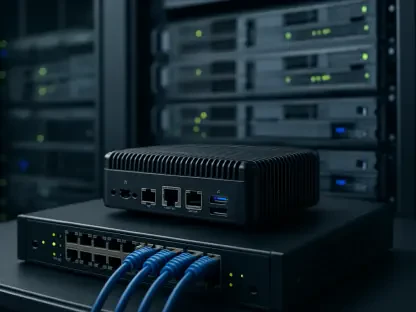In a bold leap forward for U.S. digital infrastructure, T-Mobile has rolled out its 5G Advanced network, often dubbed 5.5G, across the nation. This evolution in cellular technology promises to transform the way mobile connectivity supports daily activities. As faster internet speeds and reduced latency become accessible, activities like video conferencing and online gaming will see substantial improvements. Such advancements are crucial in an era where connectivity needs are surging, and the demand for seamless digital interactions is higher than ever. This development serves as a bridge, laying the groundwork for the upcoming era of 6G, which is anticipated to redefine communication further.
Pioneering the Path to Greater Connectivity
T-Mobile’s Strategic Role in 5G Advanced Deployment
T-Mobile has established itself as a trailblazer by becoming the first U.S. carrier to implement 5G Advanced nationwide. This move underscores an industry-wide focus on enhancing technological infrastructure and delivering superior digital experiences. The company aims to meet growing customer expectations for speed, efficiency, and reliability by leveraging improved connectivity. The 5.5G network introduces several key features that differentiate it from its predecessors, including intent-based experiences and AI-enhanced resource management. These advancements promise to deliver more stable connectivity, facilitating better interaction with wearables and IoT devices. Such improvements are essential for enabling a future where connectivity is constant and seamless, regardless of the user’s location.
However, not all devices are equipped to take full advantage of 5G Advanced. Unlike traditional 5G, this enhanced version requires specific hardware components for optimal operation. Consumers must ensure their devices are compatible, aligning with the trend where compatibility defines the user’s experience quality. Modern flagship smartphones from manufacturers like Samsung and OnePlus are already aligned with these requirements. In contrast, other models may face limitations, which necessitates informed purchasing decisions to fully exploit the network’s capabilities. Compatibility will become a deciding factor for consumers seeking to harness the benefits of this advanced technology effectively.
Bridging the Gap Between Technologies
5G Advanced serves as an interim phase between prevailing 5G tech and the anticipated future of 6G innovations, reflecting the telecom industry’s commitment to continuous improvement. This transition symbolizes an essential step in elevating performance standards prior to the advent of 6G, which is poised to revolutionize the digital landscape with unprecedented connectivity enhancements. Industry experts predict a trajectory that maximizes current technologies while strategically preparing for future breakthroughs. 5G Advanced is designed to integrate seamlessly with everyday applications, providing an enriched user experience through higher speeds and reduced latency.
The evolution also aims to fulfill the requirements of increasing IoT deployments, necessitating consistent, high-performance connectivity. By improving on existing technology, 5G Advanced enhances the operational efficiency of connected devices, which is critical as the number of connected sensors and gadgets grows exponentially. This shift directly impacts sectors beyond telecommunications, including healthcare, automotive, and smart city infrastructures, where performance and reliability are paramount. Thus, the network’s rollout is more than a technical upgrade; it symbolizes a commitment to excellence across diverse industries.
Consumer Considerations Amid Technological Shifts
Device Compatibility and Consumer Access
As consumers navigate the growing landscape of advanced connectivity, device compatibility has emerged as a crucial consideration. Not all smartphones and devices possess the requisite hardware to leverage the full potential of 5G Advanced. Flagship models like the Samsung Galaxy S25 and OnePlus 13 are outfitted with the necessary chipsets to support this network, while other models, including certain iPhone series, are not. This discrepancy necessitates that consumers remain informed about the specifications of their devices. Being aware of these technical requirements empowers individuals to make informed choices about upgrades or purchases that align with the capabilities of cutting-edge networks.
Manufacturers are anticipated to respond with newer models that align with the technological demands of 5G Advanced. As the network’s widespread adoption becomes a reality, consumers will likely see a proliferation of compatible devices entering the market. This proliferation promises to deliver a more inclusive landscape where a broader range of users can avail themselves of enhanced connectivity. The trend highlights the dynamic interplay between network providers and device manufacturers, illustrating how consumer demand drives continuous innovation and adaptation in the market. This cycle of advancement underscores the importance of staying current with technological advancements to reap their full benefits.
Preparing for 6G Innovations
Looking ahead, 5G Advanced is positioned as a stepping stone toward the transformative potential of 6G. Telecom companies are not only focusing on immediate benefits but are also strategically planning for long-term innovations. The groundwork laid by 5G Advanced will support the envisioned capabilities of 6G, which is expected to introduce transformative changes in communication, data transfer rates, and network efficiency. Companies are investing in research and development to anticipate and shape the evolution of network technologies. The insights gained during the 5.5G phase will provide critical foundations for the architecture and functionality of 6G networks.
Preparing for 6G involves addressing several challenges, including spectrum efficiency, energy consumption, and integration with emerging technologies like machine learning and quantum computing. Despite these challenges, the industry remains optimistic about the transformative impact of 6G, with its potential to redefine what is achievable in digital communication. This foresight fuels current innovations, ensuring a smoother transition to future technologies that promise even greater enhancements in speed, reliability, and connectivity. Such developments will mark a new era in mobile technology that seeks to push the boundaries of what current networks can deliver.
Transformative Impact and Future Implications
Realizing Enhanced Connectivity in Daily Life
The rollout of T-Mobile’s 5G Advanced network is set to transform everyday connectivity for users across the United States. By implementing faster speeds and lower latency, the network paves the way for digital interactions that are smoother and more immersive than ever before. Users can expect noticeable improvements in applications ranging from video conferencing to online gaming, where real-time responsiveness is crucial. These enhancements align with the modern demand for instantaneous digital interactions, where any delay can significantly impact the user experience. The 5G Advanced network is not merely about speed; it transforms the foundational aspects of connectivity that underpin daily computing needs.
This evolution also extends to business and industrial applications, where reliable and efficient connectivity is paramount. Industries that rely on real-time data processing and remote operations stand to gain from the improvements offered by 5.5G technology. Furthermore, the network’s deployment is expected to encourage innovation by providing developers with a robust platform on which to build new applications and services. As the landscape continues to evolve, leveraging these advancements becomes essential for maintaining competitive advantage and ensuring operational efficiency in various sectors. The transformative impact of this rollout reverberates across multiple facets of life and business.
Reflecting on the Future of Mobile Connectivity
In a significant stride for America’s digital landscape, T-Mobile has unveiled its 5G Advanced network, commonly referred to as 5.5G, nationwide. This advancement in cellular technology holds the potential to revolutionize the way mobile connectivity supports everyday tasks. With the arrival of faster internet speeds and diminished latency, activities such as video conferencing and online gaming are poised to experience remarkable enhancements. These improvements are essential, especially in a time where the need for constant connectivity is escalating, and the demand for flawless digital interactions is greater than ever. This rollout acts as a critical bridge, setting the stage for the forthcoming 6G era, which is poised to further transform communications. As technology continues to evolve, the anticipation surrounding 6G highlights a future where seamless interaction and connectivity could become even more integrated into our daily lives, promising unprecedented opportunities for innovation and efficiency in communication and collaboration across various sectors.









